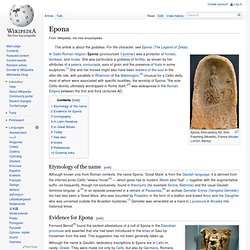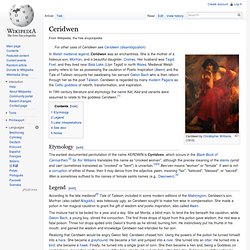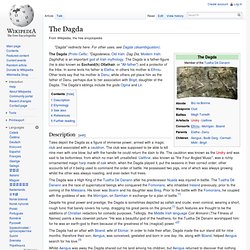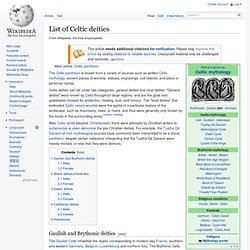

Celtic pantheon. The gods and goddesses of the pre-Christian Celtic peoples are known from a variety of sources, including written Celtic mythology, ancient places of worship, statues, engravings, cult objects and place or personal names.

In characteristic Roman fashion, Caesar does not refer to these figures by their native names but by the names of the Roman gods with which he equated them, a procedure that greatly complicates the task of identifying his Gaulish deities with their counterparts in the insular literatures. He also presents a neat schematic equation of god and function that is quite foreign to the vernacular literary testimony. Yet, given its limitations, his brief catalog is a valuable witness. General characteristics[edit] Supra-regional cults[edit] Epona. Epona, third century AD, from Freyming (Moselle), France (Musée Lorrain, Nancy)

Ceridwen. In Welsh medieval legend, Ceridwen was an enchantress.

She is the mother of a hideous son, Morfran, and a beautiful daughter, Creirwy. Her husband was Tegid Foel, and they lived near Bala Lake (Llyn Tegid) in north Wales. Medieval Welsh poetry refers to her as possessing the cauldron of Poetic Inspiration (Awen) and the Tale of Taliesin recounts her swallowing her servant Gwion Bach who is then reborn through her as the poet Taliesin. Ceridwen is regarded by many modern Pagans as the Celtic goddess of rebirth, transformation, and inspiration. In 19th century literature and etymology the name Ket, Ked and variants were assumed to relate to the goddess Ceridwen.[1] Etymology[edit] Legend[edit] According to the late medieval[6] Tale of Taliesin, included in some modern editions of the Mabinogion, Ceridwen's son, Morfran (also called Afagddu), was hideously ugly, so Ceridwen sought to make him wise in compensation.
The mixture had to be boiled for a year and a day. Later interpretations[edit] Lugh. 1905 illustration of Lugh's bloodthirsty magical spear by H.

R. Millar Lugh in Irish tradition[edit] The Dagda. Description[edit] Despite his great power and prestige, the Dagda is sometimes depicted as oafish and crude, even comical, wearing a short, rough tunic that barely covers his rump, dragging his great penis on the ground.[1] Such features are thought to be the additions of Christian redactors for comedic purposes.

Tellingly, the Middle Irish language Coir Anmann (The Fitness of Names) paints a less clownish picture: "He was a beautiful god of the heathens, for the Tuatha Dé Danann worshipped him: for he was an earth-god to them because of the greatness of his (magical) power. "[2] The Dagda had an affair with Bóand, wife of Elcmar. Whilst Aengus was away the Dagda shared out his land among his children, but Aengus returned to discover that nothing had been saved for him. Cernunnos. Cernunnos is the conventional name given in Celtic studies to depictions of the "horned god" of Celtic polytheism.

The name itself is only attested once, on the 1st-century Pillar of the Boatmen, but depictions of a horned or antlered figure, often seated cross-legged and often associated with animals and holding or wearing torcs, are known from other instances. Nothing is known about the god from literary sources, and details about his name, his cult or his significance in Celtic religion are unknown. Speculative interpretations identify him as a god of nature or fertility.[1] Name[edit] The theonym [C]ernunnos appears on the Pillar of the Boatmen, a Gallo-Roman monument dating to the early 1st century CE, to label a god depicted with stag's antlers in their early stage of annual growth.[2] Both antlers have torcs hanging from them.[3] The Proto-Celtic form of the theonym is reconstructed as either *Cerno-on-os[dubious ] or *Carno-on-os. Epigraphic evidence[edit] Lugus. Macha. Macha (Irish pronunciation: [ˈmaxə]) is a goddess of ancient Ireland, associated with war, horses, sovereignty, and the sites of Armagh and Eamhain Mhacha in County Armagh, which are named after her.

A number of figures called Macha appear in Irish mythology, legend and historical tradition, all believed to derive from the same deity. The name is presumably derived from Proto-Celtic *makajā denoting "a plain" (genitive *makajās "of the plain").[1] List of Celtic deities. The Celtic pantheon is known from a variety of sources such as written Celtic mythology, ancient places of worship, statues, engravings, cult objects, and place or personal names.

Celtic deities can fall under two categories: general deities and local deities. "General deities" were known by Celts throughout large regions, and are the gods and goddesses invoked for protection, healing, luck, and honour. The "local deities" that embodied Celtic nature worship were the spirits of a particular feature of the landscape, such as mountains, trees, or rivers, and thus were generally only known by the locals in the surrounding areas. [citation needed]